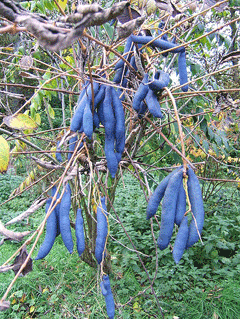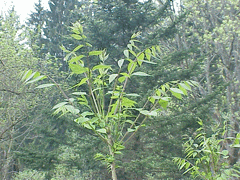 |
|
http://commons.wikimedia.org/wiki/User:MPF |
 |
| http://www.biolib.de/ |
Translate this page:
Summary
Physical Characteristics

 Decaisnea fargesii is a deciduous Shrub growing to 4 m (13ft) by 4 m (13ft) at a medium rate.
Decaisnea fargesii is a deciduous Shrub growing to 4 m (13ft) by 4 m (13ft) at a medium rate.
See above for USDA hardiness. It is hardy to UK zone 5 and is not frost tender. It is in leaf from April to October, in flower in June, and the seeds ripen from September to October. The species is hermaphrodite (has both male and female organs). The plant is self-fertile.
Suitable for: light (sandy), medium (loamy) and heavy (clay) soils. Suitable pH: mildly acid, neutral and basic (mildly alkaline) soils. It can grow in semi-shade (light woodland) or no shade. It prefers moist soil.
UK Hardiness Map
US Hardiness Map
Synonyms
Plant Habitats
Woodland Garden Sunny Edge; Dappled Shade;
Edible Uses
Edible Parts: Fruit
Edible Uses:
Fruit - raw[1, 105]. A sweet taste, but rather insipid[109]. A very nice delicate flavour according to our palates[K]. The fruit looks like a bright blue sausage or broad bean pod[K] and is up to 10cm long[200]. You peel off the skin in much the same way as you would peel a broad bean pod, this reveals a line of seed running the entire length of the fruit surrounded by a relatively thin layer of flesh[K].
References More on Edible Uses
Medicinal Uses
Plants For A Future can not take any responsibility for any adverse effects from the use of plants. Always seek advice from a professional before using a plant medicinally.
None known
References More on Medicinal Uses
The Bookshop: Edible Plant Books
Our Latest books on Perennial Plants For Food Forests and Permaculture Gardens in paperback or digital formats.

Edible Tropical Plants
Food Forest Plants for Hotter Conditions: 250+ Plants For Tropical Food Forests & Permaculture Gardens.
More

Edible Temperate Plants
Plants for Your Food Forest: 500 Plants for Temperate Food Forests & Permaculture Gardens.
More

More Books
PFAF have eight books available in paperback and digital formats. Browse the shop for more information.
Shop Now
Other Uses
References More on Other Uses
Cultivation details
An easily grown plant[182] succeeding in most soils[202], but it prefers a rich moist loamy soil and a sunny position sheltered from cold winds[175, 200]. Succeeds in partial shade[200]. Prefers partial shade, succeeding in full sun if the soil is reliably moist[202]. Dislikes drought[K]. A very cold-hardy plant when fully dormant, but the flowers and young growth in spring can be damaged by late frosts[11, 200]. Plants usually fruit well and regularly in Cornwall[11, 58] and a specimen has been seen on a number of occasions at Kew Botanical gardens laden down with fruit[K]. The flowers are produced at the tips of the new upright growths in the spring[11, 202]. Plants take some years from seed to produce fruit[202]. A very ornamental plant[1]. It is fairly fast growing but it looks gaunt and open in the winter[182]. Plants do not usually require pruning[202]. In some new floras, this species is seen as no more than a synonym for D. insignis[266]. The plant is heat tolerant in zones 9 through 7. (Plant Hardiness Zones show how well plants withstand cold winter temperatures.
Plant Heat Zones show when plants would start suffering from the heat.
The Plant Heat Zone map is based on the number of "heat days" experienced in a given area where the temperature climbs to over 86 degrees F (30°C).
At this temperature, many plants begin to suffer physiological damage. Heat Zones range from 1 (no heat days) to 12 (210 or more heat days).
For example Heat Zone. 11-1 indicates that the plant is heat tolerant in zones 11 through 1.) For polyculture design as well as the above-ground architecture (form - tree, shrub etc. and size shown above) information on the habit and root pattern is also useful and given here if available. The plant growth habit is multistemmed with multiple stems from the crown [1-2].
References Carbon Farming Information and Carbon Sequestration Information
Temperature Converter
Type a value in the Celsius field to convert the value to Fahrenheit:
Fahrenheit:
The PFAF Bookshop
Plants For A Future have a number of books available in paperback and digital form. Book titles include Edible Plants, Edible Perennials, Edible Trees,Edible Shrubs, Woodland Gardening, and Temperate Food Forest Plants. Our new book is Food Forest Plants For Hotter Conditions (Tropical and Sub-Tropical).
Shop Now
Plant Propagation
Seed - best sown as soon as it is ripe in a cold frame[200], it then usually germinates freely in early spring[K]. Sow stored seed in February in a greenhouse. This usually germinates well, within 1 - 3 months at 18°c[175]. Prick out the seedlings into individual pots as soon as they are large enough to handle and grow them on under protection for their first winter. Plant out in late spring after the last expected frosts. Cuttings.
Other Names
If available other names are mentioned here
Wu-yueh-kua-t'eng, Maoshigua, Yexiongjiao, Maoershi,
Native Range
TEMPERATE ASIA: Anhui Sheng (south), Gansu Sheng (south), Guangxi Zhuangzu Zizhiqu (east), Guizhou Sheng, Hubei Sheng, Hunan Sheng, Jiangxi Sheng, Shaanxi Sheng (south), Sichuan Sheng, Xizang Zizhiqu (southeast), Yunnan Sheng, Zhejiang Sheng (east),China. TROPICAL ASIA: Nepal,
Weed Potential
Right plant wrong place. We are currently updating this section.
Please note that a plant may be invasive in one area but may not in your area so it's worth checking.
Conservation Status
IUCN Red List of Threatened Plants Status :

Growth: S = slow M = medium F = fast. Soil: L = light (sandy) M = medium H = heavy (clay). pH: A = acid N = neutral B = basic (alkaline). Shade: F = full shade S = semi-shade N = no shade. Moisture: D = dry M = Moist We = wet Wa = water.
Now available:
Food Forest Plants for Mediterranean Conditions
350+ Perennial Plants For Mediterranean and Drier Food Forests and Permaculture Gardens.
[Paperback and eBook]
This is the third in Plants For A Future's series of plant guides for food forests tailored to
specific climate zones. Following volumes on temperate and tropical ecosystems, this book focuses
on species suited to Mediterranean conditions—regions with hot, dry summers and cool, wet winters,
often facing the added challenge of climate change.
Read More
Expert comment
Author
Franch.
Botanical References
11200266
Links / References
For a list of references used on this page please go here
Readers comment